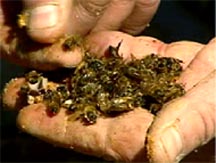“Beekeepers there in North Dakota saw so many dead bees ... and we sent some samples into a lab in Florida and they found Imidacloprid in the honey and the bees and the wax. I mean, that pretty much nails it down.”
- Daniel F. Mayer, Ph.D., Entomologist

Bayer v. Beekeepers
by Katherine Eban, October 8, 2010
from Fortune.com: "What a scientist didn't tell The New York Times
about his study on bee deaths"
As for the Bayer-Bromenshenk connection, in 2003 a group of 13 North Dakota beekeepers brought a class-action lawsuit against Bayer, alleging that the company's neonicotinoid, Imidacloprid, which had been used in nearby fields, was responsible for the loss of more than 60% of their hives. "My bees were getting drunk," Chris Charles, a beekeeper in Carrington, N.D., and a plaintiff in the lawsuit, told me in 2008. "They couldn't walk a white line anymore -- they just hung around outside the hive. They couldn't work."
Charles and the other North Dakota beekeepers hired Bromenshenk as an expert witness. Bayer did not dispute that Imidacloprid was found among the bees and their hives. The company simply argued that the amount had not been enough to kill them.
As the North Dakota lawsuit moved forward, an expert witness for the beekeepers, Dr. Daniel Mayer, a now retired bee expert from Washington State University, traveled to 17 different bee yards in North Dakota and observed dead bees and bees in the throes of what looked like Imidacloprid poisoning, he told me in 2008. He theorized that after foraging in planted fields where the seeds had been treated with Imidacloprid, the bees then brought the pesticide back to the hive, where it built up in the wax combs.
Click here to subscribe and get instant access to read this report.
Click here to check your existing subscription status.
Existing members, login below:
© 1998 - 2024 by Linda Moulton Howe.
All Rights Reserved.

